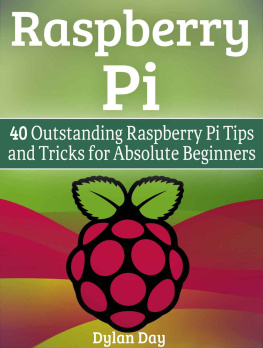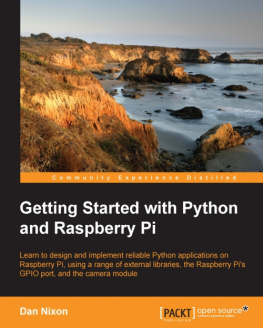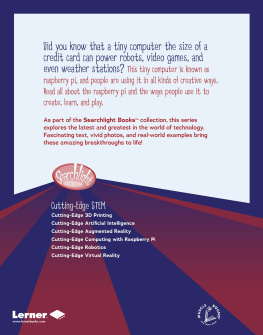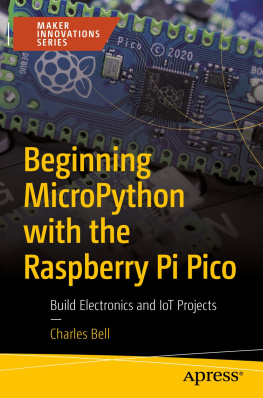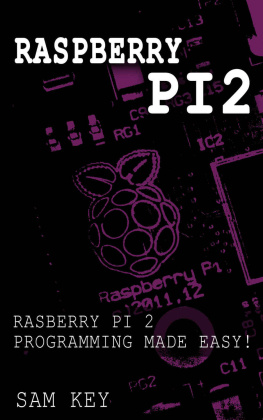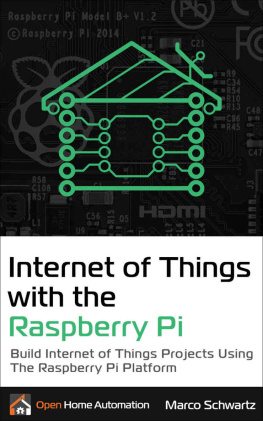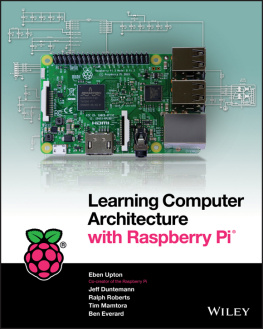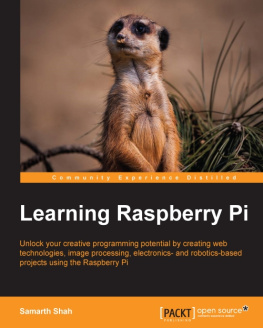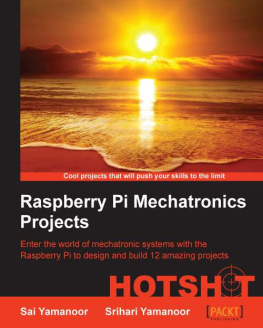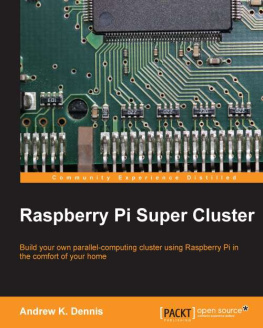Raspberry Pi
40 Outstanding Raspberry Pi Tips and Tricks for Absolute Beginners
Table of Contents
Copyright Notice
Copyright 2015 by Dylan Day - All rights reserved.
This document is geared towards providing exact and reliable information in regards to the topic and issue covered. The publication is sold with the idea that the publisher is not required to render accounting, officially permitted, or otherwise, qualified services. If advice is necessary, legal or professional, a practiced individual in the profession should be ordered.
- From a Declaration of Principles which was accepted and approved equally by a Committee of the American Bar Association and a Committee of Publishers and Associations.
In no way is it legal to reproduce, duplicate, or transmit any part of this document in either electronic means or in printed format. Recording of this publication is strictly prohibited and any storage of this document is not allowed unless with written permission from the publisher. All rights reserved.
The information provided herein is stated to be truthful and consistent, in that any liability, in terms of inattention or otherwise, by any usage or abuse of any policies, processes, or directions contained within is the solitary and utter responsibility of the recipient reader. Under no circumstances will any legal responsibility or blame be held against the publisher for any reparation, damages, or monetary loss due to the information herein, either directly or indirectly.
Respective authors own all copyrights not held by the publisher.
The information herein is offered for informational purposes solely, and is universal as so. The presentation of the information is without contract or any type of guarantee assurance.
The trademarks that are used are without any consent, and the publication of the trademark is without permission or backing by the trademark owner. All trademarks and brands within this book are for clarifying purposes only and are the owned by the owners themselves, not affiliated with this document.
Disclaimer
While all attempts have been made to verify the information provided in this book, the author does not assume any responsibility for errors, omissions, or contrary interpretations of the subject matter contained within. The information provided in this book is for educational and entertainment purposes only. The reader is responsible for his or her own actions and the author does not accept any responsibilities for any liabilities or damages, real or perceived, resulting from the use of this information.
Introduction
Embedded computing has existed for decades. But modern developments have made the process of deploying a system easier than ever before. Thanks to the wonder of Raspberry Pi and the simple and open sourced Linux platforms that will run on it, anyone can own and manage their own server to control or automate many different basic functions around the home or in the office.
Raspberry Pi is the clear leader in embedded computing platforms. With this small, easy to program computer, you can create countless projects. Our goal in this book is to introduce you to embedded computing, explain how to program and get you started.
But first a quick word about why people should know how to code. Software development has been the path to creative disruption for decades now. One of the skills necessary is fluency in simple object-oriented programming languages. These languages empower programmers to realize the vision of new technological advances. With costs of embedded computing platforms dropping, your projects can be easy to build, inexpensive to manufacture, and profitable to sell.
So let's get started with a quick history of embedded computing. We'll tour past incarnations of small programmable personal computers that fit inside and powered other devices. We'll discuss the necessary elements of building a system. Afterwards we will go through the basics of programming in Python, a simple to learn, yet remarkably powerful programming language. Many languages are either object oriented or command/function based. Python can be either. Besides, Python also has an extensive standard library of functions that you can draw on to create your application.
Finally, I will walk you through a few simple Python-Raspberry Pi projects to get you thinking. I want to inspire you to create applications that are interesting, functional and profitable. Developing a useful tool can be the basis of a fledgling business. Maybe you can get crowdfunded to bring a product to market. After that, you could score a big investment from a venture capitalist. That investor will help you scale the production of the device and get better distribution. Suddenly, you've got a business. Soon, your business is growing and appreciating in value. Before you know it, you've got offers for your business and they aren't tiny little offers. There's a lot of zeroes in the price some bigger company is willing to pay for your idea. That's disruptive change. So, let's get disrupting!
BONUS: Your FREE Gift
Thank you for purchasing my book: " Raspberry Pi ". I want to show you my appreciation by offering an exclusive Special Report TOP 10 Gadgets Of The Year for FREE.
Simply Click the Button Below

OR Go to This Page
http://bit.ly/1AiwLLM
Chapter 1 Beginners Guide to Embedded Computing
Embedded computing seems like a complicated topic, so let's simplify it some. An embedded computer lives inside a larger device. It has a specific, dedicated function within that device. Embedded computers are in effect the brains of many commonly used vehicles, appliances even our homes.
A typical embedded computer consumes very little power. They are small in size and inexpensive to make. They are just a component and their specialized function is all they do. Because they can be in a variety of environments, they tend to be more ruggedly designed.
In early iterations, embedded systems limited processing resources to keep costs low and improve reliability. That is all changing thanks to innovative embedded computers like Raspberry Pi. Instead of the older, difficult to program systems that were challenging to interface with, new systems are geared toward the do it yourself and amateur developer communities.
In other words, embedded systems are now for you and me. And with them we can build amazing things.
One aspect of embedded computing that hasn't changed, is that we can still interface multiple embedded computers to existing sensors. In doing so, we better manage our resources. This allows amateur developers to substantially increase the functionality of a device with embedded systems.
Embedded systems eschew the typical computer architecture of a main board with expansion slots. Instead they rely on either a single-board computer or an embedded system on a chip architecture. The various versions of Raspberry Pi for example are based on the Modern embedded systems are often based Broadcom's system on chip microcontrollers.
What makes embedded systems most interesting is their focus. Embedded computers do a specific task. Developers optimize the computer for that function. As a result, the units can be made smaller. Additionally, these embedded computers can be mass-produced. This in turn drives the cost down. Most critically, designers build them to be more reliable than a typical PC.
Consider, if your computer crashes while you are online it's an inconvenience. If the embedded system that controls the way your car's engine works fails, your car will fail. The consequence of that type of failure could be lethal.

